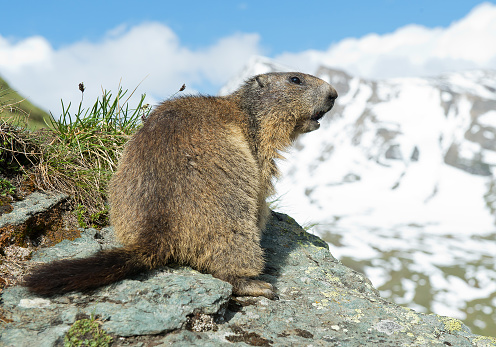
With hiking season right around the corner, let’s take a look at one of the more interesting animals you’re likely to encounter in Colorado: the marmot.
The call of the marmot is a quintessential “Colorado sound.” If you’ve spent any time in the high country in summer, you’ve probably heard the high-pitched squeak or whistle of the marmot. The marmot is another example of how Colorado breeds larger versions of more common mammals found in North America. In the same way that the moose is the largest member of the deer family, the marmot is, in fact, a large squirrel!
There are 14 species of marmots, and they can grow up to 22 inches in length and weigh up to 18 pounds. Due to the high alpine climate, marmots hibernate for up to eight months out of the year, only waking to take advantage of Colorado’s brief summers. Over a long winter’s slumber, a marmot may lose up to two-thirds of its body weight.
When awake, threats from the region’s many predators causes the marmot to be cautious while traversing the mountainsides. Wolves, foxes, coyotes, bears and even eagles will all willingly take a weary marmot if they are not quick enough to hide. Even so, these highly adaptable mammals have not only found a few niches here in Summit County to exist, but have flourished under the protection of their habitats by local and state efforts.
Summit County offers plenty of forests along the valley floors, as well as up to tree line on the slopes of our highest peaks. The marmots up here are typically more grounded and terrestrial than their smaller, more famous counterparts, squirrels. Most live in self-dug burrows, but one can even find large colonies of Marmots among the scree: rock fields at higher than tree line elevations.
One place to see whole marmot colonies is hiking Summit County’s famous pair of “14ers,” Grays and Torreys. The 14ers themselves are among the easier ones to hike, with a gently sloping valley leading up to the final ascent to the peaks. Along this valley floor and above the tree line, marmots can be found in large numbers. The first contact you will have is to hear their whistles or shrieks as the lookout alerts your presence to the rest of the colony. You will continue to hear this as you get closer and with careful looking, you will begin to see them darting to and fro from their rock tunnels. Their whistles and shrieks will continue long after you are out of view and the colony will likely remain on alert for some time after you have passed through.
Another interesting “marmot fact”: This oversized rodent has even had an impact on naming ski slopes! Because of its call and rotund appearance during the summer months, the marmot is sometimes called the “whistle pig.” For this reason, a popular ski resort in British Columbia once named “London Mountain” was renamed “Whistler” after inspiration from our mammalian friend.
So, when you’re hiking Summit County’s high trails this summer, listen for — and then, keep an eye out for — marmots. But as with all wildlife here in Colorado, we advise caution when encountering these animals. While not inherently dangerous to humans, rodents of all sizes and shapes are known carriers of diseases and should be viewed from a safe distance and absolutely not be fed in any way.
Had any encounters with marmots? Tell us about! Post a comment in the comments section below.
